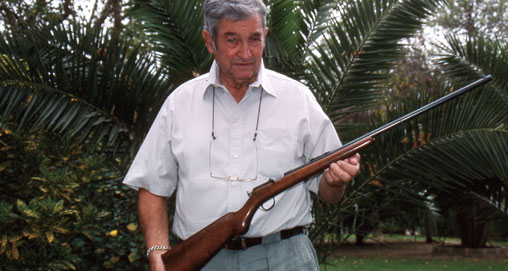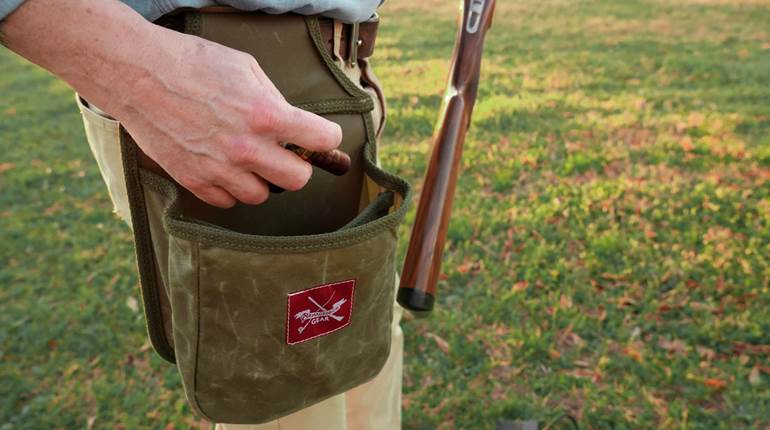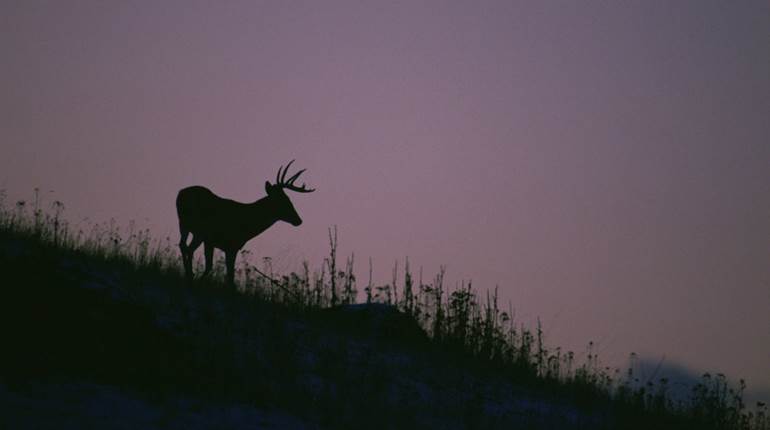
American Rifleman’s Editor-in-Chief Mark Keefe and I were sorting ammunition one evening in our tent in Botswana’s Okavango Delta when he rather casually asked, “Bob, I was wondering if you’d like to do an interview with Harry Selby for the magazine when we get back to Maun next week?” I jumped at the chance and spent the rest of the week trying to remember all the things I’d ever wanted to ask one of Africa’s most famous professional hunters.
The interview had been arranged by Joe Coogan, host of the “Benelli On Assignment” television show, and with whom Mark and I were on safari. Joe apprenticed with Harry in 1973 and worked with him as a professional hunter in Botswana for many years.
Over cigars around the campfire, Joe recounted Harry’s history: his Kenyan hunting years before the Mau Mau emergency and the politics of Kenyan independence that turned that world upside down; his move to new frontiers in Botswana in 1963; and his 40-plus years of hunting the Okavango and the Kalahari Desert. For all of us who grew up with Robert Ruark’s fascinating stories about Harry in Kenya and Tanganika in the 1950s, it’s hard to think of Harry as anything other than the quietly confident, 20-something hero of those tales. The man I would be meeting, however, was now 84 years old, with a lifetime of experiences that Ruark, who died in 1965, never had a chance to know.
We wanted to focus this interview on something different. I had heard from Harry’s son, Mark, a noted professional hunter in his own right, about Harry’s interest in the technical side of his craft—rifles, bullets, reloading—but had seen little written about it. We decided that would be the focus.
When we reach Maun, we find Harry waiting for us at the Rann Safaris office. I’m struck by how Harry listens with his eyes: keen, brown eyes that miss little. They are a hunter’s eyes, of course; and perhaps less obviously, a diplomat’s. One doesn’t spend a highly successful half-century in the bush hosting the assorted royalty of birth and commerce, meanwhile directing an even more wildly assorted staff, without possessing an acute perception of people. Harry fields my questions deftly and responds with the directness of a man who values accuracy: a rifleman’s precision.
We start with Harry’s early hunting rifles from his boyhood during the 1930s on the family farm astride the equator near Nanyuki, just west of Mount Kenya. “My first rifle of all was a little Browning .22 rimfire made in Belgium by Fabrique Nationale. It’s amazing the number of animals I killed with that little rifle, the largest being a waterbuck.” A waterbuck, by the way, is roughly the size of an elk. Harry also recalled using his .22 on deer-size game, including impala, Thompson’s and Grant’s gazelle, and predators like jackal, serval cat, and wildcat.
“My next real rifle was a .303, a British Army rifle, but not the normal .303 Lee-Enfield. It was what they called a Pattern 14, which was the made in America in .303 during the First World War. They were very accurate rifles. Parker Hale put a special peep sight on this one, and that was really the rifle I used most of my youth.” Sporting ammunition was impossible to buy during the years just before and during World War II, so they made due with full-metal-jacketed military ammunition. “Whatever we could get, even tracer bullets,” said Harry.
By his late teens, Harry had accumulated quite an impressive battery, including a Jeffrey in .318 Westley Richards and a .425 Westley Richards to accompany his .22 and .303. These were the rifles with which he began hunting professionally when he apprenticed with Philip Percival and then joined Ker & Downey Safaris in Nairobi after the war.
Harry did manage to acquire a Krupp .470 non-ejector early on, a very serviceable double, but it was not quite a fine English double. Then one day the double rifle gods smiled on him, at least temporarily. “Shortly after I joined Ker & Downey, Jack Block, the managing director, said, ‘Look, a friend of mine has a super-grade Rigby double .470 and he doesn’t use it. Shall I buy it for you?’ I said, ‘Well, it depends on what he wants for it.’ He bought that thing for me for 100 East African pounds!” At the time, this was the equivalent of approximately $300. Today, that rifle, used, would sell for upward of $40,000.
Unfortunately, safari life is hard on rifles, even a super-grade Rigby, and Harry’s double-rifle luck was not to last. “I was on safari with Donald Ker. Donald was hunting with the client and I was hunting with the gentleman’s son. I was cruising up the Grumetti River one evening and we saw a buffalo way out in the open grassland. We left the car and stalked over across a bit of swamp where we caught up to the buffalo. He was quite good, so we decided to take him. After we shot him, the driver had to go way back to bring the car around. Meanwhile, we rolled the buffalo over and started to take the cape off. There were no trees at all, so we just put our rifles down in the grass.
“I heard a car in the distance and thought it was our car. What happened is that Donald was coming up the other side and saw the vultures overhead and came over to see what was going on. He drove right over the barrels of my .470, bending them beyond any possible repair. Fortunately, the safari was just about over, so when it arrived in Nairobi he set about trying to find another double, preferably another .470 if possible, but all he could find was a .416 Rigby.”
9/16/2010
At this point alert Ruark readers are thinking, “Aha! The famous .416,” and you’re exactly right. This is the rifle Ruark made famous in “Horn of the Hunter” and Harry used for more than five decades.
“I knew the cartridge by reputation, but nothing really prepared me for the impression that I got from using that rifle—the immense knockdown, the ease of handling, the flat trajectory. In a very short time I didn’t want another double. I thought that .416 was a perfect professional hunter’s rifle. It’s been with me the rest of my hunting career. I did eventually wind up with a double .450 No. 2 just as a backup, in case something went wrong, but I hardly ever used it.”
Harry’s .416 was somewhat unusual in that Rigby built it on a standard Mauser action instead of a magnum action. Fitting the standard action to a cartridge the size of the .416 Rigby required removing metal at both ends of the action, a point that worried Harry at first. “But then again,” he noted, “I had no option so I took it, and that standard action worked perfectly for all the 50 years I used it.”
Harry’s .416 was also unusual in one other respect: It was right-handed and Harry is left-handed. “I can’t shoot a left-handed rifle,” he said. “If someone gave me a left-handed rifle I would fumble, I wouldn’t know what to do.”
As with most heavy rifles carried by professional hunters, Harry’s Rigby had fixed open sights: a wide “V” rear sight and a fine bead front sight. Harry mentioned, however, that he also liked Lyman peep sights and used them on several of his other rifles. “I’m a great proponent of the aperture sight,” he said. “Until the scope came along, it was the most accurate sight you could use because you had the longest sighting plane. I found them very fast in the thick bush.”
Harry never used a scope on his .416, but did use them on his light rifles in his later years, and he strongly recommended them for clients. “If you’re going to try and kill an animal, try and kill it cleanly. There’s no doubt about it, you are more accurate with a scope.”
I asked him whether, as he looks back over 50 years of adventures with his .416, any one shot stands out as particularly memorable. “Well, I remember on one occasion a lady hit a leopard and it took off toward a gully. A lot of professional hunters carried a shotgun in a leopard blind but I didn’t because you never knew, sometimes a lion, rhino or elephant would come wandering past. So on this occasion I had my .416 and when the leopard took off it went into this little patch of bush in the gully. As we came walking up, the leopard did a remarkable thing. Instead of holding, it broke from the gully and ran up a steep rocky incline at about 100 yards, going like a streak. I let fly with the .416 and rolled him just like that. A very lucky shot. My trackers eventually, I think, had more faith in that .416 than they did in me. ‘Skitini’ they called it—they couldn’t pronounce ‘416.’ I just had to point it, they thought, and Skitini would do the rest.”
That leopard, and virtually every other animal Harry killed with his .416, was shot with a solid bullet. While Harry used soft-nosed bullets in his light rifles, he much preferred solids for heavy game, like buffalo, rhino and elephant, and used them as well when backing up clients on lion and leopard. In part, Harry’s distrust of softs was due to early experiences with Kynoch soft points, which he found had an unfortunate habit of breaking apart. Much of his preference for solids, however, was simply the need for penetration above all else on dangerous game. The one exception to Harry’s rule on solids in the .416 came after Jack Carter’s development of the Trophy Bonded Bear Claw.
Harry recalls one particularly durable 500-grain, .458 solid, an early Hornady that had a nickel rather than bronze coating over the steel jacket. After dispatching a buffalo with the bullet from a .458 Win. Mag. he was using while his .416 was being rebarreled, Harry recovered the bullet in such good condition that he decided to load it again. He shot a second buffalo and once again found the bullet intact, so he reloaded it and used it to take a third buffalo, at which point he retired the bullet with full ballistic honors. “I would not like to give the impression that I made a habit of this,” Harry emphasized. “It was done as an experiment, but it did happen!”
I was curious about Harry’s recommendations to clients. “A lot would depend on what they’re after,” he says. “If they wanted everything from impala to elephant, I’d say start off with something like a .270 Win. or 7 mm Rem. Mag., then a .338 Win. Mag. or a .375 H&H Mag., and then if you were a magazine man I’d say a .416, and if you were a double man the .450s and .470s are all so similar, really, there’s not much difference between them. For a one-rifle safari, the .375 H&H Mag. is the only choice. No finer cartridge has ever been developed.”
Harry grins as he says this, a boy’s grin. Given Africa to roam and another 50 years, there is little doubt how he would choose to pass the time.






































